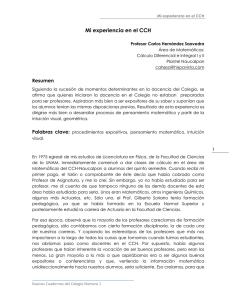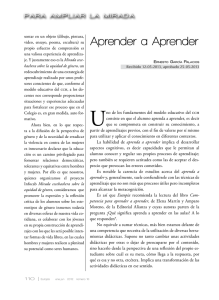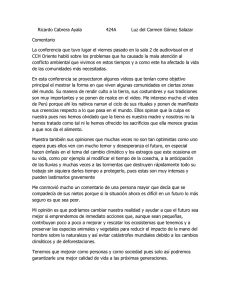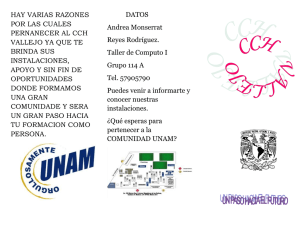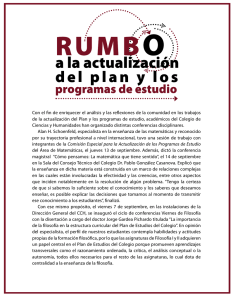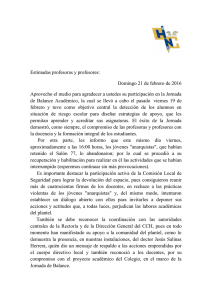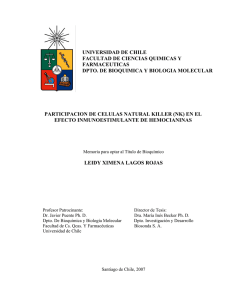participacion de celulas natural killer (nk) en el efecto
Anuncio
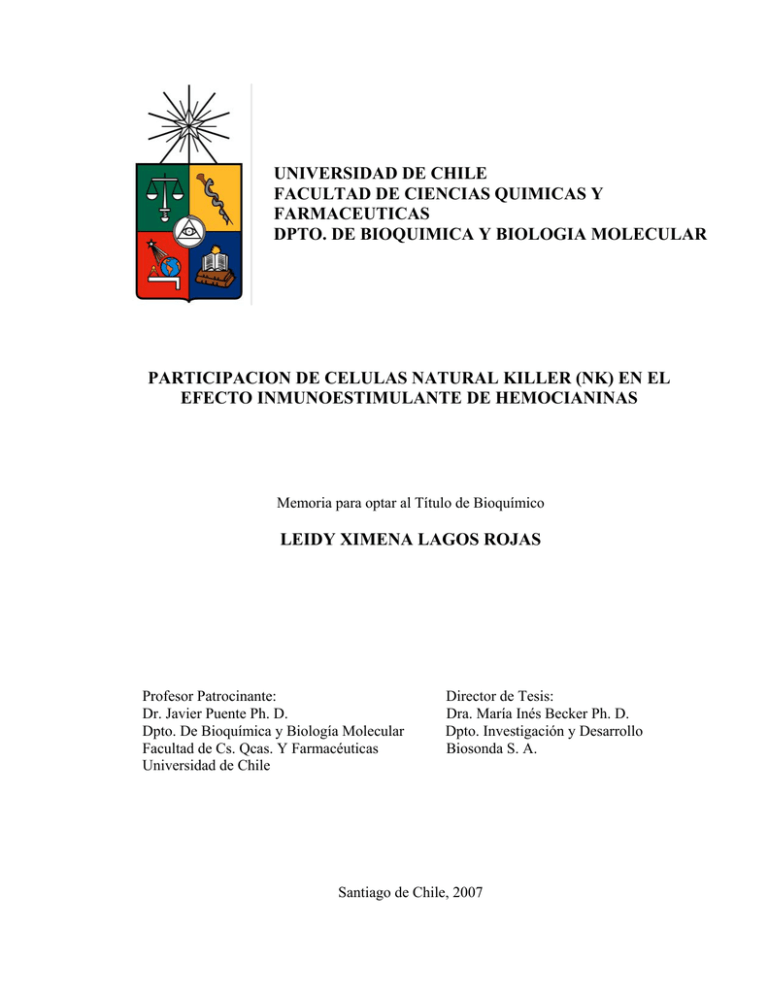
UNIVERSIDAD DE CHILE FACULTAD DE CIENCIAS QUIMICAS Y FARMACEUTICAS DPTO. DE BIOQUIMICA Y BIOLOGIA MOLECULAR PARTICIPACION DE CELULAS NATURAL KILLER (NK) EN EL EFECTO INMUNOESTIMULANTE DE HEMOCIANINAS Memoria para optar al Título de Bioquímico LEIDY XIMENA LAGOS ROJAS Profesor Patrocinante: Dr. Javier Puente Ph. D. Dpto. De Bioquímica y Biología Molecular Facultad de Cs. Qcas. Y Farmacéuticas Universidad de Chile Director de Tesis: Dra. María Inés Becker Ph. D. Dpto. Investigación y Desarrollo Biosonda S. A. Santiago de Chile, 2007 RESUMEN Las hemocianinas de moluscos son metaloglicoproteínas que transportan Oxígeno, son conocidas por su gran inmunogenicidad en los mamíferos, debida en parte a su naturaleza xenogénica, a su compleja estructura cuaternaria con epitopos repetidos y a su enorme tamaño, en torno a los 8 MDa. La hemocianina más utilizada en Biomedicina durante casi 40 años como proteína transportadora para producir anticuerpos contra haptenos y péptidos, como adyuvante en vacunas y como inmunoestimulante no específico en la terapia de ciertos tumores, se conoce como KLH y proviene del molusco californiano comúnmente llamado Keyhole limpet (Megathura crenulata). En los años recientes, nuestro laboratorio ha demostrado que CCH, la hemocianina del gastrópodo chileno Concholepas concholepas (Loco) tiene propiedades inmunomoestimulantes similares a KLH como proteína transportadora, adyuvante y como agente antitumoral no específico. Con respecto a los mecanismos inmunológicos involucrados, hemos encontrado que en ratones sensibilizados con KLH o CCH, se produce un aumento de la actividad de las células NK y un perfil de citoquinas del tipo Th1, con el concomitante cambio de subclases de IgG1 a IgG2a, sugiriendo por primera vez que el sistema inmune de los mamíferos reconoce un patrón-hemocianina, independientemente de la especie y de su organización, ya que KLH y CCH difieren en su estructura cuaternaria. Sorprendentemente, el efecto inmunomodulador de las hemocianinas no requiere de adyuvantes adicionales, lo que nos lleva a plantear en este trabajo la hipótesis que las hemocianinas inducen señales que promueven inflamación a nivel de la inmunidad innata. Es así que en este trabajo se estudió el efecto de hemocianinas per se sobre células NK de ratones naive, evaluando cambios fenotípicos y funcionales tanto in vitro como in vivo, utilizando diversas técnicas de microscopía de luz y electrónica, citometría de flujo y ensayos de citotoxicidad, con hemocianina sola o conjugada el fluorocromo AlexaFluor 488. Los resultados muestran que se estableció la metodología para cultivar células NK de ratón in vitro, mediante selección negativa de esplenocitos con esferas magnéticas, encontrándose que en torno a los 10 días alcanzan el estado de mayor madurez. Su caracterización fenotípica mostró que ellas expresan los marcadores propios de dichas 2 células (CDNK1.1+ CD49+ CD11c-) y desde el punto de vista funcional, secretan IFNγ. Los estudios con diferentes dosis de CCH, no mostraron variaciones en la expresión de dichos marcadores, ni en la intensidad de su expresión, pero sí se encontró un efecto a nivel de la maduración, reflejado por el predominio de células de mayor tamaño con respecto al cultivo control, algunas de las cuales mostraron vacuolas con CCH en su interior. Sin embargo, se determinó que CCH no ejerce efecto alguno sobre la capacidad humoral (secreción de IFNγ) y citotóxica de las células NK cultivadas in vitro. Los experimentos in vivo, al igual que in vitro, mostraron por primera vez, que existe una subpoblación de células NK que incorporan CCH al igual que otras células linfoides analizadas y entre ellas células dendríticas, macrófagos y linfocitos B. Sin embargo, a diferencia de los resultados in vitro, si se encontró por primera vez, que CCH induce un aumento en la actividad de células NK a las 24 horas de inyectada en animales naive con respecto a los controles, resultado que abre numerosas interrogantes sobre los mecanismos de inmunoestimulación de estas facinantes proteínas. 3 SUMMARY The hemocyanins from mollusk are metallo-glicoproteins that transport Oxygen. They are known for their immunogenicity in the mammals, due to their xenogenic nature, to complex quaternary structure with repeated epitopes, and their enormous size, around to 8 MDa. The hemocyanin used in Biomedicine, during almost 40 years, as carrier protein to produce antibodies against haptens and peptides, as adjuvant in vaccines, and as non specific immunostimulant in the therapy of certain tumors, is known as KLH, and is obtained from Californian mollusk Keyhole limpet (Megathura crenulata). In the recent years, our laboratory has demonstrated that CCH, the hemocyanin from the Chilean gastropod Concholepas concholepas (Loco) has immunostimulant properties similar to KLH, as carrier protein, adjuvant, and as non specific antitumor agent. With respect to the immunological mechanisms involved, we found that in mice sensitized with KLH or CCH, an increase of the activity of NK cells occurs, a profile of cytokines of the Th1 type is produced, with a concomitant change of subclasses of IgG1 to IgG2a, suggesting for the first time, that the mammal immune system recognizes a pattern-hemocyanin, independently of the species and its organization, since KLH and CCH differ in their quaternary structure. Interestingly, the immunomodulatory effect of the hemocyanins does not require of additional adjuvants, thus, in this work the hypothesis is that the hemocyanins induce signals that promote inflammation at level of the innate immunity. In this work, the effect of hemocyanin is studied on NK cells naïve mice, evaluating phennotypic and functional changes both in vitro and in vivo. With this aim, we use diverse techniques of light and electron microscopy, flow cytometry, and citotoxicity assay, with CCH and CCH conjugated with the fluorochrome AlexaFluor 488. The results show that we established the methodology to culture mouse NK cells in vitro, by means of negative selection of spleen cells with magnetic beads. The NK culture around day 10, reach the state of greater maturity. Their phenotypic characterization showed that the cells express the markers-cell surface antigens of these cells (CDNK1.1+ CD49+ CD11c-) and from the functional point of view, they secrete IFNγ. The studies with different doses from CCH did not show variations either in the level expression of these markers or in their intensity, however and effect in the maturation was observed: the predominance of cells of greater size with respect to the control culture, some of which showed vacuoles containing CCH. Nevertheless, we determined that CCH exerts no effect some on the humoral capacity (release of IFNγ) and cytotoxic of the NK cells cultured in vitro. The experiments in vivo, like in vitro, showed for the first time that a subpopulation of NK cells incorporate CCH, in addition to other lymphoid cells as dendritic cells, macrophages and B lymphocytes. Unlike the results in vitro, we found for the first time, that CCH induces an increase in the activity of NK cells after 24 hours of injected in animals naive with respect to the control, result that opens numerous questions on the immunostimulating mechanism of these fascinating proteins.
